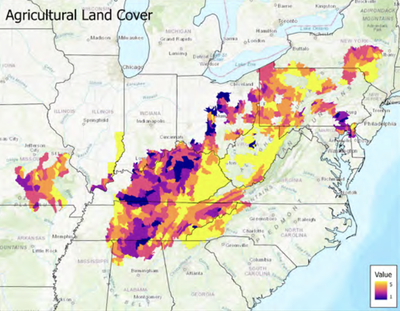Eastern Hellbender Partner Website
 The Eastern Hellbender Partner Website was funded for NRCS and its partners to collaborate in support of private landowners to implement Working Lands for Wildlife partnership.
The Eastern Hellbender Partner Website was funded for NRCS and its partners to collaborate in support of private landowners to implement Working Lands for Wildlife partnership.
The USDA’s Natural Resources Conservation Service (NRCS) is working to address recovery of the hellbender in three states: North Carolina, Tennessee and Virginia. Priority watersheds have been identified in a 35-county range of the Upper Cumberland, the Lower Tennessee system, and the western watersheds of North Carolina. These priority counties are home to some of the last known existing hellbender populations in these systems.
Private landowners are part of the solution.
NRCS will conduct targeted outreach in focal areas within defined priority watersheds that cumulatively consist of approximately 6,000 acres of land and nearly 100 miles of streambank conservation. This effort will promote conservation practices that enhance habitat for the hellbender and many other aquatic species. Our conservationists will work with private landowners and agricultural producers to plan conservation practices that directly and/or indirectly improve water quality for the hellbender and a variety of other aquatic species through activities such as grazing management, reduced agricultural runoff and instream barrier removal.
Own or manage land? You can help.
NRCS offers free technical and financial assistance to help producers plan and implement a variety of conservation activities or practices that will not only support the recovery of the hellbender but also benefit entire ecosystems.
The agency’s staff and conservation partners work side-by-side to develop conservation plans tailored to meet the needs and objectives of each landowner while adhering to program targeted goals and site conditions. These plans provide the necessary roadmap for how to use conservation practices to meet natural resource and production goals.
Producers can also receive financial assistance to help pay for the adoption of conservation systems that improve the health of aquatic ecosystems. Some common conservation practices may include riparian forest buffers (NRCS Code CP-391), field borders (NRCS Code CP-386), or fencing (NRCS Code CP-382).
Working Lands for Wildlife
This project is part of the NRCS’ Working Lands for Wildlife (WLFW) partnership, a collaborative approach to conserving habitat on working lands. Working Lands for Wildlife provides technical and financial assistance through the Environmental Quality Incentives Program and Regional Conservation Partnership Program to help landowners install practices to restore riparian buffers, reduce stream bank erosion and sedimentation, and minimize nutrient inputs from fertilizer and livestock waste.
Habitat restored for the hellbender benefits many other species, including the Bog turtle, Appalachian elktoe or even the brook trout.
Content Link: NRCS Eastern Hellbender Website





















